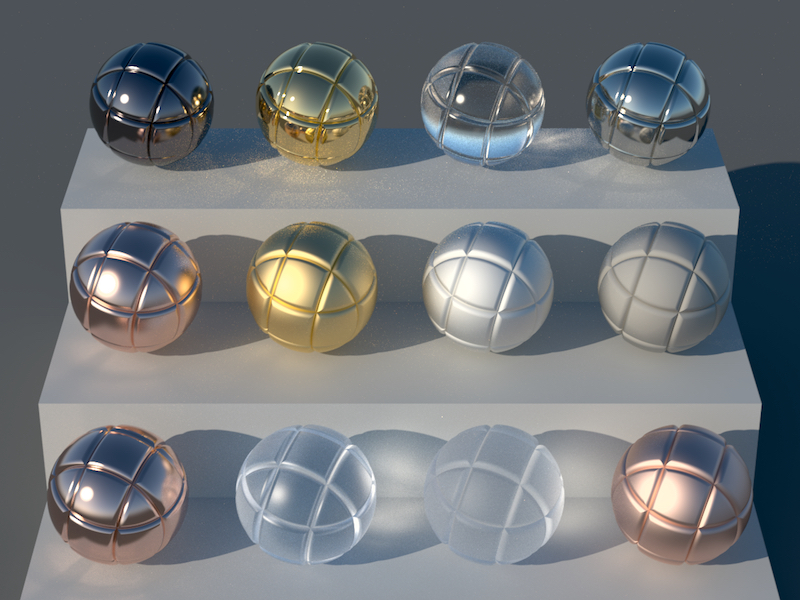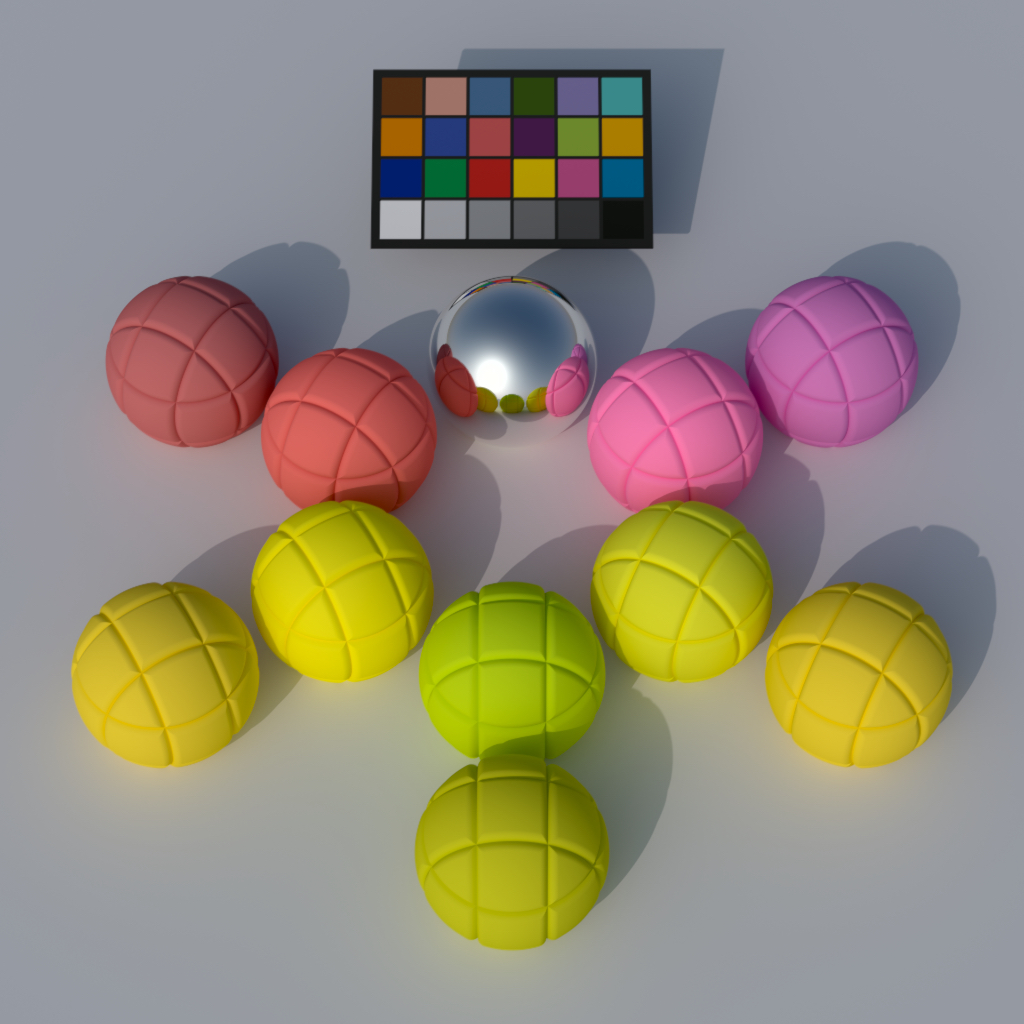|
I defended my PhD on December 2019 at the University Grenoble-Alpes under the supervision of Nicolas Holzschuch. The subject of my PhD is efficient representation for measured reflectance.
I did a year gap (2017-2018) in Czech Republic at Charles University in Computer Graphics Group under the supervision of Alexander Wilkie and Jaroslav Křivánek.
Publications
Find a complete list of ofther publications of our team here.
2022
-
- titre
- Efficient Storage and Importance Sampling for Fluorescent Reflectance
- auteur
- Qingqin Hua, Vojtěch Tázlar, Alban Fichet, Alexander Wilkie
- article
- Computer Graphics Forum, 2022, ⟨10.1111/cgf.14716⟩
- resume
- We propose a technique for efficient storage and importance sampling of fluorescent spectral data. Fluorescence is fully described by a reradiation matrix, which for a given input wavelength indicates how much energy is reemitted at other wavelengths. However, such representation has a considerable memory footprint. To significantly reduce memory requirements, we propose the use of Gaussian mixture models for the representation of reradiation matrices. Instead of the full-resolution matrix, we work with a set of Gaussian parameters that also allow direct importance sampling. Furthermore, if accuracy is of concern, a reradiation matrix can be used jointly with efficient importance sampling provided by the Gaussian mixture. In this paper, we present our pipeline for efficient storage of bispectral data and provide its extensive evaluation on a large set of bispectral measurements. We show that our method is robust and colour accurate even with its comparably minor memory requirements and that it can be seamlessly integrated into a standard Monte Carlo path tracer.
- DOI
- DOI : 10.1111/cgf.14716
- Accès au texte intégral et bibtex
-


2021
-
- titre
- Efficient Spectral Rendering on the GPU for Predictive Rendering
- auteur
- David Murray, Alban Fichet, Romain Pacanowski
- article
- Ray Tracing Gems II, Springer, pp.673 - 698, 2021, 978-1-4842-7185-8. ⟨10.1007/978-1-4842-7185-8_42⟩
- resume
- Current graphic processing units (GPU) in conjunction with specialized APIs open the possibility of interactive path tracing. Spectral rendering is necessary for accurate and predictive light transport simulation, especially to render specific phenomena such as light dispersion. However, it requires larger assets than traditional RGB rendering pipelines. Thanks to the increase of available onboard memory on newer graphic cards, it becomes possible to load larger assets onto the GPU, making spectral rendering feasible. In this chapter, we describe the strengths of spectral rendering and present our approach for implementing a spectral path tracer on the GPU. We also propose solutions to limit the impact on memory when handling finely sampled spectra or large scenes.
- DOI
- DOI : 10.1007/978-1-4842-7185-8_42
- Accès au texte intégral et bibtex
-


-
- titre
- An OpenEXR Layout for Spectral Images
- auteur
- Alban Fichet, Romain Pacanowski, Alexander Wilkie
- article
- Journal of Computer Graphics Techniques, 2021
- resume
- We propose a standardised layout to organise spectral data stored in OpenEXR images. We motivate why we chose the OpenEXR format as basis for our work, and we explain our choices with regard to data selection and organisation: our goal is to define a standard for the exchange of measured or simulated spectral and bi-spectral data. We also provide sample code to store spectral images in OpenEXR format.
- Accès au texte intégral et bibtex
-


-
- titre
- A Compact Representation for Fluorescent Spectral Data
- auteur
- Qingqin Hua, Alban Fichet, Alexander Wilkie
- article
- Eurographics Symposium on Rendering, Jun 2021, Saarbrücken, Germany
- resume
- We propose a technique to efficiently importance sample and store fluorescent spectral data. Fluorescence behaviour is properly represented as a re-radiation matrix: for a given input wavelength, this matrix indicates how much energy is re-emitted at all other wavelengths. However, such a 2D representation has a significant memory footprint, especially when a scene contains a high number of fluorescent objects, or fluorescent textures. We propose to use Gaussian Mixture Domain to model re-radiation, which allows us to significantly reduce the memory footprint. Instead of storing the full matrix, we work with a set of Gaussian parameters that also allow direct importance sampling. When accuracy is a concern, one can still use the re-radiation matrix data, and just benefit from importance sampling provided by the Gaussian Mixture. Our method is useful when numerous fluorescent materials are present in a scene, an in particular for textures with fluorescent components.
- Accès au texte intégral et bibtex
-


2018
-
- titre
- Handling Fluorescence in a Uni-directional Spectral Path Tracer
- auteur
- Michal Mojzík, Alban Fichet, Alexander Wilkie
- article
- Computer Graphics Forum, 2018, 37 (4), pp.77 - 94. ⟨10.1111/cgf.13477⟩
- resume
- We present two separate improvements to the handling of fluorescence effects in modern uni-directional spectral rendering systems. The first is the formulation of a new distance tracking scheme for fluorescent volume materials which exhibit a pronounced wavelength asymmetry. Such volumetric materials are an important and not uncommon corner case of wavelength-shifting media behaviour, and have not been addressed so far in rendering literature. The second one is that we introduce an extension of Hero wavelength sampling which can handle fluorescence events, both on surfaces, and in volumes. Both improvements are useful by themselves, and can be used separately: when used together, they enable the robust inclusion of arbitrary fluorescence effects in modern uni-directional spectral MIS path tracers. Our extension of Hero wavelength sampling is generally useful, while our proposed technique for distance tracking in strongly asymmetric media is admittedly not very efficient. However, it makes the most of a rather difficult situation, and at least allows the inclusion of such media in uni-directional path tracers, albeit at comparatively high cost. Which is still an improvement since up to now, their inclusion was not really possible at all, due to the inability of conventional tracking schemes to generate sampling points in such volume materials.
- DOI
- DOI : 10.1111/cgf.13477
- Accès au texte intégral et bibtex
-


2016
-
- titre
- Capturing Spatially Varying Anisotropic Reflectance Parameters using Fourier Analysis
- auteur
- Alban Fichet, Imari Sato, Nicolas Holzschuch
- article
- Graphics Interface Conference 2016, Jun 2016, Victoria, BC, Canada. pp.65-73, ⟨10.20380/GI2016.09⟩
- resume
- Reflectance parameters condition the appearance of objects in photorealistic rendering. Practical acquisition of reflectance parameters is still a difficult problem. Even more so for spatially varying or anisotropic materials, which increase the number of samples required. In this paper, we present an algorithm for acquisition of spatially varying anisotropic materials, sampling only a small number of directions. Our algorithm uses Fourier analysis to extract the material parameters from a sub-sampled signal. We are able to extract diffuse and specular reflectance, direction of anisotropy, surface normal and reflectance parameters from as little as 20 sample directions. Our system makes no assumption about the stationarity or regularity of the materials, and can recover anisotropic effects at the pixel level.
- DOI
- DOI : 10.20380/GI2016.09
- Accès au texte intégral et bibtex
-


Reseach Project
Joined the long time running developpement of ART, The Advanced Rendering Toolkit, initialy developped by Robert f. Tobler, currently maintained by Alexander Wilkie during my year in Czech Republic.



Visit the ART website for more information.
Shadertoy
Here is a collection of my Shadertoys.
Click on the picture to see the shader (Javascript from Fabrice Neyret, see his collection : here).






Usefull stuff
Softwares
OpenEXR Thumbnailer (Linux)
Display thumbnails / preview of your OpenEXR files in your filemanager:
Install on Ubuntu:
sudo add-apt-repository ppa:alban-f/openexr-thumbnailer sudo apt-get update sudo apt install openexr-thumbnailer
OpenEXR gThumb extension
gThumb extension to support display of OpenEXR format:
Install on Arch Linux:
yay -Sy yay -S gthumb-openexr-extension
OpenEXR / TIFF conversion tools
OpenEXR conversion tools from TIFF and to PNG:
Code snippets
File transfert on UNIX
Between two UNIX stations (or by installing netcast on Windows) :
-
Find the IP address of the receiving station.
For example usingifconfig. -
On the receiving station:
nc -l [port] > [filename]
For examplenc -l 2266 > foo.tar On the emitting station:
cat [filename] | nc [ip_receiving_station] [port]
For examplecat foo.tar | nc 192.168.0.5 2266
File transfert with HTML5
With sharedrop.io service: www.sharedrop.io.
Convert to UTF-8
To guess the character encoding of a file, you can type:
file -bi [filename]
This will return something like:
text/plain; charset=us-ascii
If it is us-ascii, you file is already UTF-8 compatible. That does just mean it doesn't contains characters out of ASCII encoding scope.
Then, to convert your file to UTF-8, type:
iconf -f [from-charset] -t utf8 [filename] > [new filename]
Seen here.







